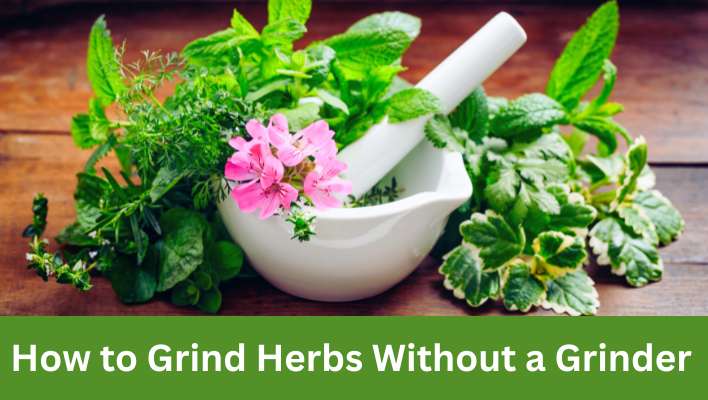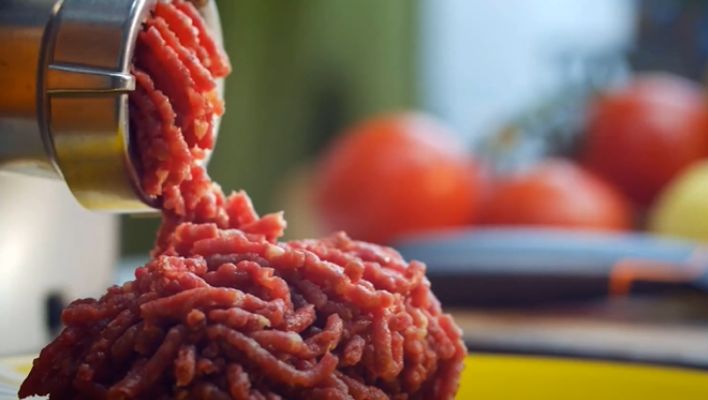To grind herbs without a grinder, use a mortar and pestle or a coffee grinder. Grinding herbs without a grinder can be a challenge, especially when you need finely ground herbs for cooking or medicinal purposes.
However, you don’t necessarily need a grinder to achieve the desired result. We will explore two alternative methods that you can use to grind your herbs effectively. By using either a mortar and pestle or a coffee grinder, you can easily break down the herbs and create a fine powder or coarser ground, depending on your preference.
These methods are simple, affordable, and accessible, making them excellent options for anyone looking to grind herbs without a grinder. So, let’s dive in and learn how to get started with these alternative methods.
Crushing Herbs With A Mortar And Pestle
When it comes to grinding herbs without a grinder, using a mortar and pestle is a time-tested and traditional method that not only does the job effectively but also adds a touch of authenticity to your kitchen rituals. This ancient technique allows you to release the oils and flavours locked within your herbs, ensuring a fine consistency that enhances the taste and aroma of your culinary creations.
Traditional Method For Grinding Herbs
Using a mortar and pestle is an age-old method employed by cultures around the world. This simple yet powerful tool consists of two parts: a mortar, a small bowl-like container made of material such as ceramic, marble, or stone, and a pestle, a heavy, club-shaped instrument used to crush and grind the herbs within the mortar.
By applying gentle pressure and a circular motion with the pestle, you can effectively break down the herbs, releasing their flavours and essential oils. It’s a slow and meditative process that allows you to connect with the ingredients on a deeper level, infusing your dishes with the love and care you put into preparing them.
Read Also: How To Grind Dried Herbs Into Powder?
How To Select The Right Mortar And Pestle

Choosing the right mortar and pestle is crucial to ensuring an optimal grinding experience. Here are a few tips to help you select the best one for your needs:
- Consider the material: Your mortar and pestle should be made of sturdy material like granite, marble, or volcanic stone to withstand the pressure and friction during grinding.
- Size matters: Select a mortar and pestle with a size that suits your grinding needs. If you regularly grind large quantities of herbs, opt for a larger mortar and pestle.
- Weight and stability: Ensure that your mortar is heavy enough to stay in place while you grind, providing stability and preventing it from sliding around your countertop.
Proper Technique For Crushing Herbs Effectively
To crush herbs effectively with a mortar and pestle, follow these simple steps:
- Select a clean and dry mortar and pestle.
- Place a small amount of herbs into the mortar, enough to cover the bottom without overcrowding.
- Hold the pestle firmly in your hand, making sure it’s comfortable to grip.
- Apply downward pressure while grinding the herbs in a circular motion. Start with a gentle motion and gradually increase the pressure to achieve the desired consistency.
- Continue grinding until the herbs are finely crushed and have released their aroma and oils.
- Transfer the crushed herbs to a clean container using a spoon or spatula, ready to be used in your recipes.
By following these steps, you can ensure that each herb is crushed effectively, preserving its fragrance and flavour for your culinary adventures. Embrace the traditional method of grinding herbs with a mortar and pestle and experience the joy of creating authentic flavours in your kitchen.
Grinding Herbs With A Coffee Grinder
Grinding herbs is an essential part of the culinary process, whether you’re preparing a delicious homemade curry or making herbal tea. While many people rely on traditional herb grinders for this task, not everyone has one readily available in their kitchen. But fear not! If you find yourself in a pinch and without a dedicated herb grinder, a coffee grinder can be a lifesaver. In this article, we’ll explore how to use a coffee grinder as an alternative tool for grinding herbs. Let’s dive in!
Using A Coffee Grinder As An Alternative Tool
When it comes to grinding herbs without a grinder, a coffee grinder can be an excellent substitute. Coffee grinders are designed to grind coffee beans into a fine powder, making them an ideal tool for pulverizing herbs as well. While some may argue that the flavours of coffee and herbs may mix, fear not! With a few simple tips and precautions, you can use a coffee grinder to achieve perfectly ground herbs for all your culinary needs.
Read Also: How to Clean Metal Herb Grinder: The Ultimate Guide
Tips For Preparing The Coffee Grinder
Before you start grinding herbs with a coffee grinder, it’s important to ensure that the grinder is properly prepared. Follow these simple tips to get the best results:
- Cleanse: Begin by thoroughly cleaning the coffee grinder to remove any lingering coffee residue. This will help prevent any unwanted flavours from transferring to your herbs. You can use a mild detergent and warm water to clean the grinder, followed by a thorough rinsing.
- Dry: After cleaning, ensure that the coffee grinder is completely dry before using it. Excess moisture can compromise the grinding process and make it difficult to achieve a fine powder consistency.
- Blade Sharpness: Check the sharpness of the grinder’s blades. Dull blades can lead to uneven grinding and may even damage the herbs. If the blades are dull, it might be worth considering sharpening or replacing them for optimal performance.
Step-by-step Process For Grinding Herbs With A Coffee Grinder
Now that the coffee grinder is prepared, it’s time to start grinding your herbs. Follow these steps for the best results:
- Prepare the Herbs: Ensure the herbs are properly dried; fresh herbs contain more moisture, which can affect the final consistency. Remove any stems or unwanted parts from the herbs and break them into smaller pieces for easier grinding.
- Batch Size: Carefully consider the batch size to ensure optimal results. Overloading the coffee grinder with too many herbs can lead to uneven grinding. It’s advisable to grind the herbs in smaller batches, giving the grinder enough space and time to process them evenly.
- Grind Time: Start by pulsing the herbs instead of continuously running the grinder. This technique helps achieve a more consistent grind and prevents overheating. Begin with short pulses of three to five seconds, pausing in between to check the progress and redistribute the herb particles.
- Check for Consistency: After each pulse, check the consistency of the ground herbs. If you’re looking for a fine powder, continue pulsing until the desired texture is achieved. For a coarser texture, pulse the herbs for a shorter duration. Remember to avoid overgrinding, as it can result in a powdery mess.
- Sift if Desired: If you prefer a finer texture and want to remove any larger pieces or fibres, you can sift the ground herbs through a fine mesh sieve or use a mesh tea ball to strain out the larger particles.
- Store Properly: Once the herbs are ground to your satisfaction, transfer them to an airtight container to preserve their freshness and flavour. Keep the container away from direct sunlight and moisture to maintain its quality.
With these simple steps, you can easily grind herbs using a coffee grinder, even without a dedicated herb grinder. Remember to clean and prepare the coffee grinder beforehand, and be mindful of the batch size and grinding time to achieve the desired consistency. Happy herb grinding!
Grinding Herbs With A Blender Or Food Processor
Grinding herbs is an essential step in releasing their flavors and aromas, but what if you don’t have a grinder on hand? Don’t worry! Using a blender or food processor can be an excellent alternative for breaking down herbs into a fine consistency. In this guide, we will take you through the process of grinding herbs with a blender or food processor, providing you with tips to achieve the desired consistency. Let’s get started!
Using A Blender Or Food Processor For Herb Grinding
Blenders and food processors are versatile kitchen appliances that can be used for various culinary tasks. Grinding herbs is one of them! Below, we will walk you through the steps of using a blender or food processor to grind your herbs:
Preparing The Blender Or Food Processor For Herb Grinding
Before you begin grinding your herbs, it’s essential to prepare your blender or food processor properly. Follow these steps to ensure optimal results:
- Make sure your blender or food processor is clean and dry. Any residual food particles might affect the flavor or smell of your herbs.
- Remove any previous ingredients or attachments that might impact the taste of your herbs.
- For blenders, ensure the blade is securely attached to the base.
- For food processors, assemble the correct blade or attachment for grinding.
Tips For Achieving Desired Consistency When Using A Blender Or Food Processor
When using a blender or food processor to grind herbs, achieving the desired consistency can be a bit tricky. However, following these tips will help you get the result you desire:
- Start with small quantities of herbs to prevent overcrowding in the blender or food processor, which can lead to uneven grinding.
- Pulse the herbs instead of using continuous blending or processing. This helps break them down without turning them into a paste.
- Consider adding a small amount of salt or sugar to the herbs before grinding. This can act as an abrasive and assist in achieving a finer consistency.
- Stop occasionally and check the texture of the herbs. If needed, scrape down the sides and continue grinding until you reach the desired consistency.
By following these steps and tips, you can successfully grind herbs using a blender or food processor. Remember to clean your appliances thoroughly after use to remove any herb residue that might affect the flavors of future dishes. Happy grinding!
Grinding Herbs With A Knife And Cutting Board
Grinding herbs without a grinder may seem like a daunting task, but fear not! If you don’t have a grinder on hand, you can still achieve perfectly ground herbs using a simple knife and cutting board. This manual method not only allows you to control the grind consistency but also delivers the same aromatic and flavorful results. In this section, we will explore the manual method for grinding herbs using a knife and cutting board, the best knife and cutting board for herb grinding, and techniques to effectively chop and grind herbs, all without the need for a grinder.
Manual Method For Grinding Herbs Using A Knife And Cutting Board
If you’re wondering how to grind herbs without a grinder, using a knife and cutting board is a fantastic manual alternative. This method gives you total control over the grind size and is quite straightforward. Here’s a step-by-step guide on how to do it:
- Begin by selecting a knife suitable for herb grinding. A sharp chef’s knife or a Santoku knife works best for this task.
- Next, gather a sturdy cutting board that offers sufficient surface area to comfortably chop and grind your herbs.
- Place the desired amount of herbs onto the cutting board.
- Hold the knife by the handle and use a rocking motion to chop the herbs into small pieces. Keep your fingers tucked in and use the knuckles to guide the knife. Repeat this motion until the herbs are finely chopped.
- Now, gather the chopped herbs into a pile in the centre of the cutting board.
- Using the flat part of the knife blade, press down on the herbs and briskly move them back and forth over the chopped herbs. Continue this motion until the desired grind consistency is achieved.
- Collect the ground herbs and transfer them to a container for storage or immediate use.
Best Knife And Cutting Board For Herb Grinding
When it comes to grinding herbs with a knife and cutting board, selecting the right tools can make a significant difference in the overall outcome. Here is a recommendation for the best knife and cutting board:
| Knife | Cutting Board |
|---|---|
| Chef’s Knife Choose a high-quality chef’s knife with a sharp blade. The length of the blade should be between 8-10 inches, allowing for efficient chopping and grinding of herbs. | Wooden Cutting Board A wooden cutting board is ideal for herb grinding due to its sturdy surface and natural integrity. Ensure the board is large enough for comfortable herb chopping and grinding. |
Techniques For Effectively Chopping And Grinding Herbs With A Knife
To ensure efficient herb grinding using a knife and cutting board, follow these techniques:
- Rocking Motion: Utilize a rocking motion while chopping herbs to create consistent and even-sized pieces.
- Knuckle Guide: Keep your fingers tucked in and use your knuckles to guide the knife while chopping, ensuring safety and control.
- Back-and-Forth Motion: When grinding the herbs, use the motion of moving the knife back and forth over the chopped herbs to achieve the desired grind consistency.
- Apply Even Pressure: Use the flat part of the knife blade to press down on the herbs firmly, ensuring consistent grinding without excessive force.
With these techniques and the right tools, you can easily grind herbs without a grinder, achieving fresh and flavorful results every time. So, the next time you find yourself without a grinder, grab a knife and cutting board, and let the manual method work its magic!
Frequently Asked Questions On How To Grind Herbs Without A Grinder
How Do You Crush Herbs Without A Grinder?
To crush herbs without a grinder, you can use a mortar and pestle, a rolling pin, or a knife. Simply apply pressure and grind or chop the herbs until they reach your desired consistency. Alternatively, you can place the herbs in a plastic bag and use a heavy object to crush them.
How Do You Grind Flowers Without A Grinder?
To grind flowers without a grinder, you can use alternative methods such as using a mortar and pestle, a coffee grinder, a blender, or even your hands to finely chop or crush the flowers into a powder. Be sure to use clean and dry tools for better results.
Is It Necessary To Have A Herb Grinder?
Yes, having a herb grinder is necessary. It helps in grinding herbs, making it easier to extract flavors and aromas when cooking or using them for medicinal purposes. A grinder ensures a consistent texture, enhances potency, and allows for better control of the herb’s usage.
Conclusion
Grinding herbs without a grinder may seem challenging, but it’s quite simple with the right techniques. By using common household items like a mortar and pestle, a coffee grinder, or even a rolling pin, you can easily achieve the desired consistency for your herbs.
This method is not only cost-effective but also allows you to have more control over the texture of your herbs. So, next time you find yourself without a grinder, don’t fret. Get creative and unleash the flavors in your kitchen with these alternative methods!





